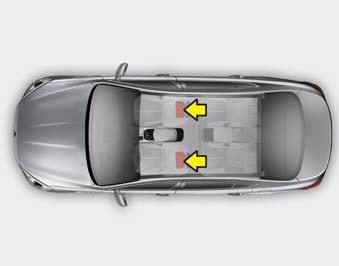 Kia K900: Headrest (for front seat)
Kia K900: Headrest (for front seat)

The driver's and front passenger's seats are equipped with a headrest for the occupant's safety and comfort.
The headrest not only provides comfort for the driver and front passenger, but also helps protect the head and neck in the event of a collision.
For maximum effectiveness in case of an accident, the headrest should be adjusted so the middle of the headrest is at the same height of the center of gravity of an occupant's head. Generally, the center of gravity of most people's head is similar with the height of the top of their eyes.
Also, adjust the headrest as close to your head as possible.
For this reason, the use of a cushion that holds the body away from the seatback is not recommended.
WARNING
Headrest removal/adjustment
- Do not operate the vehicle with the headrests removed. Headrests help provide critical neck and head support in a crash.
- Do not adjust the headrest height while the vehicle is in motion. Driver may lose control of the vehicle.
 Easy access function
Easy access function
When exiting the vehicle, the steering wheel will move away from the driver and
the seat will move rearward when the engine is turned off.
When entering the vehicle, the steering wheel will move to ...
 Forward and backward adjustment
Forward and backward adjustment
The headrest may be adjusted forward or rearward by pulling the lower part of
the headrest forward or rearward to the desired detent in the direction of the arrow.
Adjust the headrest so that it ...
See also:
Pursuant to Code of Federal Regulations, Title 47, Part 15 ("FCC Rules")
Operation is subject to the following two conditions:
1.This device may not cause harmful interference, and
2.This device must accept any interference received, including interference that
may cau ...
Recommended lubricants and capacities
To help achieve proper engine and powertrain performance and durability, use
only lubricants of the proper quality.
The correct lubricants also help promote engine efficiency that results in improv ...
Necessary inspections
Fluid levels, such as engine oil, engine coolant, brake fluid, and washer fluid
should be checked on a regular basis, with the exact interval depending on the fluid.
WARNING
Distracted driving
Fo ...
